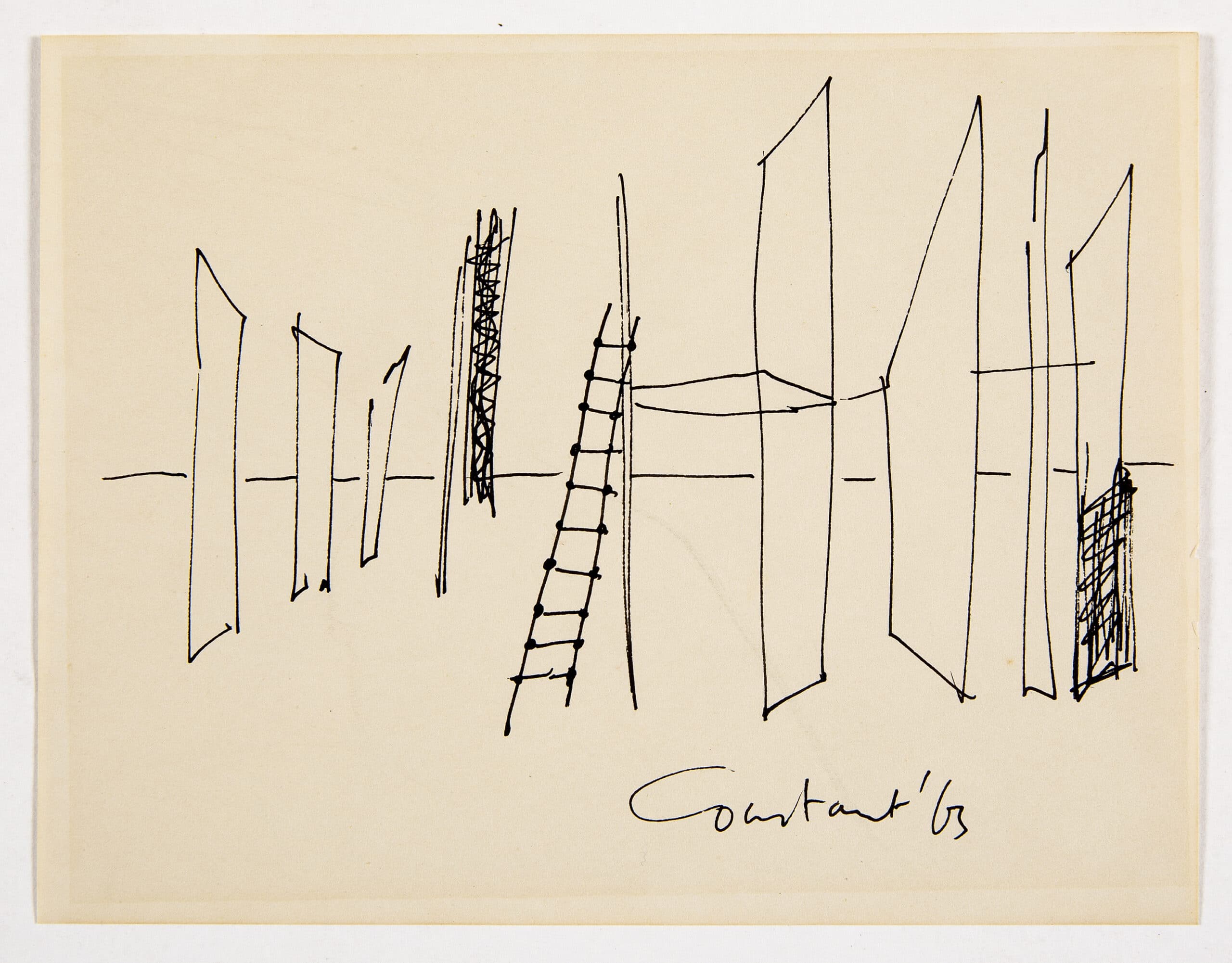Constant’s Ladders as Mythic Entity

The ladder, a seemingly unexceptional instrument within the array of futuristic and utopian architectural schemes, sits front and centre; the protagonist of not only this drawing but of Constant’s almost two-decade-long project, spanning 1956–1974, entitled ‘New Babylon’. Propped somewhat haphazardly against a series of horizontally-connected and vertically-angled planes, it exudes an everydayness, while offering the observer a relatable and scaled object amongst the otherwise abstracted series of rectangular forms. The ladder becomes the viewer’s invitation to enter not only New Babylon as an idea but New Babylon as mythmaking.
A common symbolic dweller amongst Constant’s drawings, the ladder embodies contortionist forms and stretches fantastical spans that become vital in his criticism of the techno-capitalist, modern homo faber with a proposal for unlocking the creative potential of man through play.[1] Constant engages with mythmaking as a form of communication; a language that—building upon semiotics—succeeds in suppressing the message of the sign, reconstructing it into a new entity.[2] The sign is the associative totality of the signifier and the signified, it is a supplementary consequence, a third element that is dependent on the direct alignment between the initial object in question and its symbolic message.[3] However, under the hypnotic power of myth, the sign is dislocated from its original symbolic order and proceeds to endure a series of mutations that deny historical continuity and favour a newly constructed associative meaning.[4] It is through this disruption in continuity that Constant’s ladder symbolically transfers the dialectical tensions between homo faber and homo ludens, from technological dependency to creative freedom.[5]
While the act of changing perceptions is fundamentally difficult and goes against the instincts of the psyche, which innately seeks to return to the familiar and reject any re-territorialization of meaning, Constant’s unitary urbanism critically proposes the re-articulation of objects, boundaries, and materials.[6] The ladder—the two uneven ‘parallel’ lines of which the ten cross-braces are marked with circles at the respective intersections—begins to occupy the space between politics, history, and poetics. Constant’s ladder does not seek to determine another absolutist vision, but rather becomes an instrument of subversion, returning the agency to the viewer, to the perceivers to interpret the new potentialities that redeem their own social meaning and cultural power.
Vehemently aware of the criticisms of utopian visions, he writes in the text Another City for Another Life, that the project ‘risks being taken for a fantastic dream.’[7] He distinguishes the desirable, the indispensable and the feasible in correspondence with the human, social, and technical standpoints respectively. However, it could be argued that the feasibility of New Babylon emerges not from a technical application, but from a mythical one; in the potential to create new alternatives for present conditions. Through his drawings, Constant’s varying expressions of the ladder distance it from its origins as a rigid functional tool and comes to embody a spirit of its own as a mythic entity, playing with the positive potentials of myth that—rather than asserting a new fundamentalist ideology—re-write the fragments of the past into new narratives, new concoctions. Barthes found that for one to reflect upon myth, one must lend oneself to history to ‘reflect on the existing notions that claim to be “natural” and “universal” despite their origin.’[8] It is this oxymoron that Constant’s ladders occupy, whereby Constant addresses the creation of myths not through an attempt to re-align them to a presumptuous accuracy, but to re-direct their forces to propagate new ones as mythic entities.
Notes
- Pascal Gielen, Pedro G. Romero, Laura Stamps, Willemijn Stokvis, Trudy van der Horst and Mark Wigley, Constant: New Babylon (Madrid: Edition Museo Nacional Centro de Arte Reina Sofia, 2015).<https://issuu.com/museoreinasofia/docs/constant._ingl__s> [accessed 28 October, 2023], 13. Based on Marx’s definition of Homo faber (‘Man the maker’) would be replaced by Homo ludens (‘Man the player’) in which technology would automate all ‘noncreative’ acts such as work, shopping or cooking and the New Babylonian could focus entirely on their creative development, unbound by place or time.
- Roland Barthes, Mythologies (Paris: Points, 1957), 133. Barthes denotes Saussure’s contribution to an understanding of mythology as part of semiology: ‘myth in fact belongs to the province of a general science, coextensive with linguistics, which is semiology.’
- Ibid., 133.
- Ibid., 137. Barthes gives examples of material objects including photography, painting, posters and rituals, where these objects of ‘mythical speech’ may be different at the start but ‘are reduced to a pure signifying function as soon as they are caught by myth.’
- Constant: New Babylon. Man as the player.
- Ibid., 8. Alongside Guy Debord, Constant was a predominant figure in the Situationist International under which they wrote the manifesto ‘La Déclaration d’Amsterdam,’ defining the parameters of unitary urbanism. Among the defining elements was to advance the automation of work to relinquish the creative potential of man and interaction between artistic practice, social research and technological opportunities. Unitary urbanism sought to create ‘an endless diversity of what they called environments and situations that would contribute to the realization of a richer and more fulfilled life.’
- Ibid., 9.
- Barthes, Mythologies (Paris: Points, 1957), 135.
Alison Bartlett is an architectural designer and researcher whose work takes the form of writing, drawing and material explorations that seek to formalize the political and aesthetic operativity of historical objects. Based in London, she has recently completed her MPhil dissertation at the Architectural Association, in which she investigated the production of nationalist identities entombed within architectural artefacts. She continues to pursue these topics as an Associate Lecturer at the Royal College of Art.
This text is one of the selected responses to the Open Call: Storytellers, Observed—an inquiry into the origin and circumstances of a single drawing (or series of drawings), observing the ways by which each achieves the specific purpose for which it was made. For further information click here.

– Laurence Le Bras and Emmanuel Guy